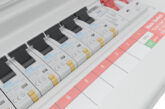
Mike Collins, Managing Director at Ovia, provides an overview of Technical Memorandum 66 (TM66) and its efforts to create a circular economy in the lighting industry.
The UK generated 40.4 million tonnes of commercial and industrial waste in 2020. The EU estimates (2023) that member states produce more than 2.2 billion tonnes of total waste every year. Electronic waste has increased 47% whilst the population has only grown by a 9% in the same time span (2010-2018). This is unsustainable.
The current model of product development is ‘linear’; that is, ‘Raw materials – Design – Production – Distribution – Consumption – Collection – Waste Management/Landfill’, or simplified to ‘Take, Make, Use, Shred/Landfill’. It is this model that has raised the amount of electronic waste to unsustainable levels.
The circular economy is a model of production and consumption which places the emphasis on, ‘…sharing, leasing, reusing, repairing, refurbishing and recycling existing materials and products for as long as possible’. The circular model, highlighted by the image below, provides for greater opportunities to use, reuse, or remake prior to recycling, waste management and/or landfill. This model has the aim of significantly reducing waste.
TM66: 2021 Creating a circular economy in the lighting industry, published by CIBSE ‘…sets out what designing and manufacturing to comply with circular economy principles entails and includes a checklist, a method of assessing a product’s circular economy performance, and real-world examples of good practice.’
TM66 recognises the UK government’s strategy to eliminate avoidable waste by 2050 and to this end the target is to move the lighting industry towards using fewer resources, making products more efficient and effective by using, for example, replaceable parts. However, this is a simplistic consideration when considering the whole of TM66.
TM66 provides practical guidance to all elements of the lighting industry, including clients, manufacturers, specifiers, wholesalers, designers and the like, in how they might better take account of all the factors which impact upon the use, re-use and re-make of lighting products.
Circular economy and design
To ensure that any lighting product follows the ‘circular economy’ model, designers must purposefully design products that follow the user’s needs whilst operating a system whereby resources, manufacturing, distribution, use and re-use of components are given due account in the design of the product.
The circular economy takes account of making use of recycled materials, but it’s more accurate to emphasise the need to design waste out of the process at the initial design phase.
For example, where an existing luminaire has failed or the space has changed its use, circular economy thinking doesn’t simply throw the luminaire(s) away, rather consideration is given to whether the luminaire can be re-imagined, re-manufactured or used in alternative locations.
The key question is: how do we retain the maximum value of the luminaire? That is, how can a luminaire be kept at the highest level of economic and functional value for as long as possible? The challenge for manufacturers is to engage with this change in the nature of its design, production and distribution systems.
The clear ‘direction of travel’ within the lighting industry, and one to which Ovia is committed, is to align with the government’s strategic plan to eliminate waste.
Circular Economy Assessment Method – CEAM
The Circular Economy Assessment Method (CEAM) uses two spreadsheets (‘Make’ and ‘Specify’), authored and developed by industry specialists (including the Lighting Industry Association – LIA), and are used to enable manufacturers and specifiers to assess their lighting products, and develop their systems as they work to align with the circular economy over time.
The use of CEAM is not an environmental audit. It is there to guide manufacturers and others in the areas where action should/could be taken to improve their alignment with the circular economy. CEAM incorporates a scoring system, giving a clear value of where a manufacturer of lighting products stands in a circular economy environment. Table 1 (below) of TM66 shows the scoring system.
Ovia works hard to improve its circular economy and a range of its lighting products have been certified TM66 circularity with LIA/CIBSE in the range 1.5 – 2.5 (based on the scores in Table 1). Circular economy and the next steps Ovia is committed to working towards improving its circular economy for its lighting products. However, the lighting industry is at a relatively early stage of understanding and applying the principles of the circular economy.
It is widely recognised that significant improvements in lighting efficiency have taken place with the introduction of LEDs, and progress continues to be made. However, for example, where LEDs and the like continue to be sent for disposal rather than considered for re-use or re-manufacture then the underlying principles of the circular economy are clearly not being understood and applied.
More broadly, the lighting industry needs to work at educating the relevant sectors within the industry to grasp the challenges and benefits of the circular economy.
Other areas of necessary future development detailed within TM66 include environmental auditing, technical obsolescence (particularly as it relates to controls), incentives and corporate objectives and ethics and responsibilities.
Conclusion
Legislation, standards and the need for manufacturers to be able to design, make and sell in the UK and into the wider European and world markets, will force designers, specifiers, manufacturers and the like to positively engage with the circular economy.
The incorporation of TM66 and CEAM is a useful way in which businesses can assess where they’re at in terms of their direction of travel towards products being designed for use, re-use and re-making.
Browse the latest edition of Ovia Lighting product catalogue online here
Find more industry feature articles here












